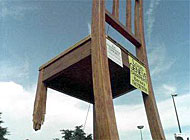Broken chairs symbolise suffering of landmine victims

As Geneva hosts an international conference on landmines, a long line of broken red chairs is forming along the city's lakeside. The work, by the artist Daniel Berset, symbolises the people who will be maimed by mines during the conference.
Berset is the creator of Geneva’s famous Broken Chair, which stands in the Place des Nations, outside the United Nations building. He was approached by the Swiss government and asked to produce another sculpture for this latest conference.
“The slogan of this conference is ‘Every Minute Counts’, so this is seeks to use that concept of tragic time. It’s a logical extension from the Broken Chair,” Berset told swissinfo.
The work, entitled “The Red Line”, consists of a line of broken red chairs along the Quai Wilson, near the Office of the High Commissioner for Human Rights.
It’s estimated that every 20 minutes, someone somewhere in the world is killed or injured by a landmine. Berset is adding a chair to the line every 20 minutes, night and day, to symbolise this. By the end of the conference there will be some 300 chairs stretching along the lakefront.
“Today when we hear the news and hear of people dying, it’s shocking, but then later, we switch off our minds,” Berset says.
“When you see this line of chairs representing how many landmines have gone off in the space of a few days, it leaves an impression in your mind and it’s harder to forget,” he says.
The conference is seeking to improve the implementation of the Ottawa Convention, which bans the use, stockpiling, production and export of these weapons. A number of leading countries – including the United States, Russia and China – have refused to sign the treaty.
Switzerland is one of over 130 countries that has signed the Ottawa Convention, and one of 21 that has completely destroyed all its landmines.
Several landmine victims who are in Geneva for the conference have visited the chairs and come away impressed.
“It’s been very moving,” Berset says. “Their response has been important for me. I haven’t been injured and I can only use symbolic or poetic language to support them, but their reaction has been the best thing about the Red Line so far.”
Berset’s giant Broken Chair, which has had one of its legs blown off, was placed in the Place des Nations in 1997 to mark an earlier landmine campaign. It was meant to be temporary, but it has become one of the most powerful and best-known pieces of public art in Switzerland.
“The Broken Chair has no official status. The politicians don’t seem to want to get rid of it, but they haven’t decided to keep it either,” Berset says.
“I would like them to take a decision to keep it in Geneva. It’s a symbol of injured humanity and Geneva plays an important humanitarian role in the world,” he adds.
If the Broken Chair is a lasting symbol, the Red Line is something very different.
“It’s very much rooted in time. It would be impossible to keep the Red Line as it is,” the artist says.
“Throughout history, artists have always been engaged. They have a particular language and it’s up to them to use it. My language is visual. If I can use that to help a cause, then that’s good.”
by Roy Probert

In compliance with the JTI standards
More: SWI swissinfo.ch certified by the Journalism Trust Initiative
You can find an overview of ongoing debates with our journalists here . Please join us!
If you want to start a conversation about a topic raised in this article or want to report factual errors, email us at english@swissinfo.ch.